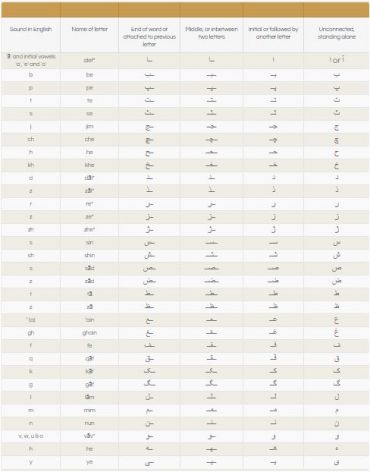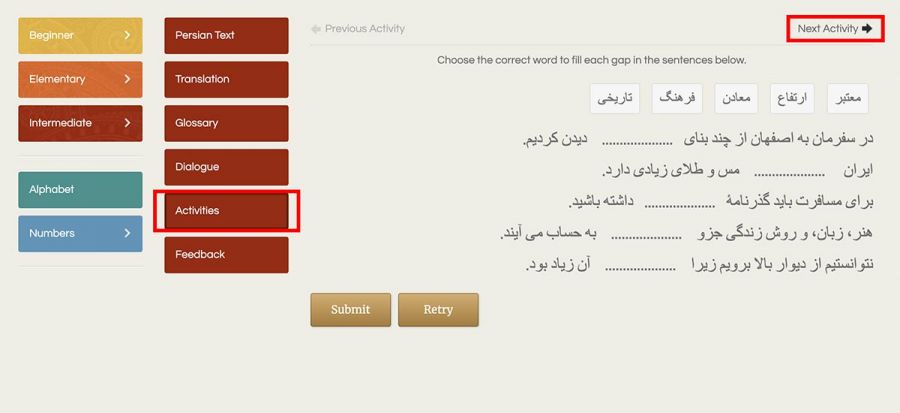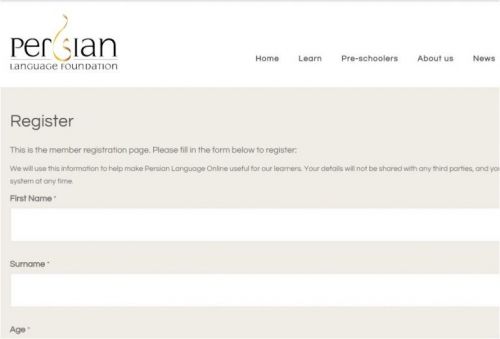
Project 6060 – Lesson 57
-
EN
Lesson 57
A few of Sa’di’s Tales
***
Translation
A tale is one of the types of short story and it expresses moral points within the framework of an adventure. Many of the writings of Iranian greats are in the form of tales. One of the books that is renowned in this field is the book, ‘Golestan’; a work of Sa’di, the great Iranian writer of the thirteen century AD. ‘Golestan’ is one of the most famous Persian prose masterpieces and was written in the year 1277. This book has eight chapters and expresses moral, educative and social issues. Sa’di uses poetry in his tales as well. One of Sa’di’s most famous poems in Golestan is the poem ‘Children of Man’, which begins with the following couplet:
The children of man are, together, related As out of one gemstone, together, created.
This poem is so important that Barak Obama, the then President of the United States of America, recited this poem in his Nowruz message to the Iranian people in the year 2009. In addition, in the negotiations hall of the United Nations in New York, there is a carpet on which the poem ‘Children of Man’ has been written. This poem has also been selected for a collection of messages for the spaceship ‘Voyager’ to send to space. Before writing the Golestan, Sa’di wrote another book of poetry, which is called ‘Bustan’. To continue, you will read a few tales from Sa’di’s Golestan:
The Grateful Devotee
I saw a devotee beside the sea, who had been wounded by a panther and no medicine was healing him. He had been in pain for a long time and thanked God. They asked him, “What are you giving thanks for?” He said, “Thanks that I have been overcome by disaster, not sin.”
The Servant and the King
A king sat with his servant on a ship to go on a journey. Since the servant was seeing the sea for the first time, and until that time had not seen the suffering of seafaring, he began to cry and get impatient out of fear. His unrest caused the king to become disturbed. The king’s entourage were looking for a solution, until a sage said to the king: “If you give the order, I will calm him down somehow.”
The king said: “If you can do that, you will have done me a favour.”
The sage said: “Order them to throw the servant into the sea.”
The king issued this very order. They threw him into the sea. In the sea he was yelling: “Help! Save me!”
In the end, they grabbed his hair and pulled him inside the ship. He sat in a corner of the ship and said nothing more.
The king was surprised by the order of the sage and asked him: “What was the wisdom behind this that caused the servant to calm down?”
The sage replied: “At first, he hadn’t tasted the suffering of drowning and didn’t appreciate his own health, and so it is the person who has previously experienced disaster that knows their own wellness.
Eye Ache
A man had a sore eye. To find a cure, he went to a vet. The vet dropped into his eye that which he would put into the eye of a donkey and he went blind. The man took his complaint to a judge and said: This vet thought I was a donkey and put in my eye that which he puts in the eyes of donkeys and I went blind.
The judge said: No blame lies with the vet; if you weren’t a donkey, you would have known not to go to a vet when there are proficient doctors.
The Highest Form of Worship
One of the unjust kings asked a devotee; “Of all the forms of worship, which is the highest?”
The devotee said: “For you, to sleep in the middle of the day is the best worship, so that in that time you won’t oppress the people.”
The Black of the World
They put a parrot and a crow together in a cage. When the parrot saw the crow, it said: “The black of your feathers is like the dark of the night, the distance from me to you is that from East to West. I never thought I would be sitting with a crow. For anybody who starts each day seeing you in the morning, that day will become dark and dull for them; is there anything blacker and darker than you in the world?
But the black crow had become tired of sitting with the beautiful parrot and said: “Oh God, you gave me neither beauty, nor wrote me a beautiful fate. I don’t deserve to be both in a cage and tormented by my companion. What have I done that this has happened to me? I am much more content when I’m on the wall of a garden with a crow for company. The wise suffers when sitting with a fool and the fool is afraid upon seeing the wise.
As you have seen in the tales of the Golestan, each one tells a story in the words of characters that are either people or animals. Usually, these tales contain advice and teach moral points.
-
FR
Leçon 57
Quelques histoires de Sa’di
***
Traduction
Coming soon
-
ES
Lección 57
Algunos de los cuentos de Sa’di
***
Traducción
Coming soon
-
FA
درس پنجاه و هفتم
چند حکایت از سعدی
***
متن فارسی
حکایت از انواع داستان های کوتاه است و نکاتی اخلاقی را در قالب ماجرایی بیان می کند. بسیاری از نوشته های بزرگان ایران به صورت حکایت هستند. یکی از کتاب هایی که در این زمینه مشهور است، کتاب «گلستان» اثر سعدی شاعر و نویسندۀ بزرگ ایرانی در قرن سیزدهم میلادی است.
«گلستان» یکی از معروف ترین شاهکارهای نثر فارسی است و در سال ۱۲۷۷ نوشته شده است. این کتاب هشت فصل دارد و با استفاده از حکایات مسائل اخلاقی، تربیتی و اجتماعی را بیان می کند. سعدی در حکایت های خود از شعر هم استفاده می کند. یکی از مشهورترین شعرهای سعدی در گلستان، شعر «بنی آدم» است که با بیت زیر آغاز می شود:
بنی آدم اعضای یک دیگرند که در آفرینش ز یک گوهرند
اهمّیّت این شعر تا اندازه ای است که باراک اوباما رئیس جمهور وقت ایالات متّحدۀ آمریکا در پیام نوروزی خود با مردم ایران در سال ۲۰۰۹ این شعر را بیان کرد. به علاوه، در سالن مذاکرات سازمان ملل متّحد در نیویورک فرشی وجود دارد که شعر «بنی آدم» بر روی آن نوشته شده است. همچنین این شعر برای مجموعه پیام های فضاپیمای “وُیِجِر” برای ارسال به فضا برگزیده شده است. قبل از نوشتن «گلستان»، سعدی کتاب دیگری را به شعر نوشت که «بوستان» نام دارد. در ادامه چند حکایت از گلستان سعدی را می خوانید:
پارسای شاکر
پارسایی را دیدم بر کنار دریا که زخم پلنگ داشت و با هیچ دارو بهتر نمی شد. مدّت ها درد داشت و شکر خدا می گفت. از او پرسیدند: شکر چه می گویی؟
گفت: شکر آنکه به مصیبتی گرفتارم نه معصیتی.
نوکر و پادشاه
پادشاهى با نوکرش در کشتى نشست تا سفر کند. از آنجا که آن نوکر نخستین بار بود که دریا را مى دید و تا آن وقت رنج هاى دریانوردى را ندیده بود، از ترس به گریه افتاد و بى تابى کرد. ناآرامى او باعث شد که آسایش شاه به هم بخورد. اطرافیان شاه به دنبال چاره بودند، تا اینکه حکیمى به شاه گفت: اگر فرمان دهى من او را به طریقى آرام مى کنم.
شاه گفت: اگر چنین کنى به من بسیار لطف کرده اى.حکیم گفت: فرمان بده نوکر را به دریا بیندازند.
شاه چنین فرمانى را صادر کرد. او را به دریا انداختند. او در دریا فریاد مى زد: کمک کنید! مرا نجات دهید!
سرانجام موی سرش را گرفتند و به داخل کشتى کشیدند. او در گوشه اى از کشتى نشست و دیگر چیزى نگفت .
شاه از این دستور حکیم تعجّب کرد و از او پرسید: حکمت این کار چه بود که باعث آرامش غلام شد؟
حکیم جواب داد: او اوّل رنج غرق شدن را نچشیده بود و قدر امنیّت در کشتی را نمى دانست، همچنین قدر عافیت را آن کس داند که قبلاً گرفتار مصیبت گردد.چشم درد
مردی چشم درد داشت. برای درمان پیش بیطار رفت. بیطار از آنچه که در چشم خَرها می کرد در چشم او ریخت و کور شد . مردک شکایت به قاضی برد و گفت: این بیطار من را خر فرض کرد و از آنچه که در چشم خرها می ریخت در چشم من ریخت و کور شدم.
قاضی گفت: بر بیطار هیچ تاوان نیست اگر تو خر نبودی با حضور طبیبان حاذق پیش بیطار نمی رفتی.
بالاترین عبادت
یکی از پادشاهان بی انصاف، از پارسایی پرسید: از عبادت ها کدام بالاتر است.
پارسا گفت: برای تو خواب نیم روز بهترین عبادت است، تا در آن زمان به مردم ظلم نکنی.
سیاهی دنیا
طوطی و کلاغی را با هم در قفسی کردند. طوطی که کلاغ را دید گفت: سیاهی پرهای تو مانند تاریکی شب است، فاصلۀ بین من و تو از شرق تا غرب است. هیچ گاه فکر نمی کردم با کلاغی همنشین شوم. هر صبحگاه کسی که روزش را با دیدن تو آغاز کند، آن روز برایش تیره و تار می شود، آیا سیاهتر و تاریک تر از تو در دنیا هست؟
امّا کلاغ سیاه هم از همنشینی با طوطی زیبا خسته شده بود و می گفت: خدایا نه زیبایی به من دادی و نه سرنوشت زیبایی برایم نوشتی. سزای من این نیست که هم در قفس باشم و هم آزار همنشین ببینم. چه کردم که چنین عاقبتی دارم. من همین که بر دیوار باغی با کلاغی همراه شوم آسوده خاطرم. دانا از همنشینی با نادان رنج می کشد و نادان از دیدن دانا هراسان می شود.همان طور که در حکایت های گلستان دیدید، هر کدام داستانی را از زبان شخصیّت هایی که انسان یا حیوان هستند بیان می کند. معمولاً این حکایت ها دارای پند هستند و نکته ای اخلاقی را آموزش می دهند.
DIALOGUE
DIALOGUE
DIÁLOGO
مُکالِمه
-
EN
Translation of Dialogue
Maryam: Have you read Sa’di’s books?
Bahman: I have read a few of the poems from Sa’di’s book, ‘Bustan’, but in my opinion the tales in ‘Golestan’ are more interesting. I prefer them.
Maryam: How come?
Bahman: Well, for me they’re a little bit easier to read. And their stories are interesting.
Maryam: I agree. I’ve learnt lots of things from it too.
Bahman: His poem ‘Children of Man’ is very famous.
Maryam: Yeah, the president of America read it once.
Bahman: I heard that this poem is written above the door of the United Nations.
Maryam: No, you’re mistaken. It’s just written on a carpet that is in one of the rooms of the United Nations.
Bahman: How interesting! So sometimes they give false information in these books and websites.
Maryam: That’s right. -
FR
Traduction de Dialogue
Coming soon
-
ES
Traducción de Diálogo
Coming soon
-
FA
متن فارسی مُکالمه
مریم: کتابای سعدی رُ خوندی؟
بهمن: کمی از شعرای کتاب «بوستان» سعدی رُ خوندم امّا به نظرم حکایتای «گلستان» جالب تره. اونا رُ بیشتر دوست دارم.
مریم: چطور؟
بهمن: خُب، خوندنش برام یه کم راحت تره. داستاناشم جالبه.
مریم: موافقم. منم خیلی چیزا ازش یاد گرفتم.
بهمن: شعر بنی آدمش خیلی معروفه.
مریم: آره، یه بار رئیس جمهور آمریکا اونُ خوند.
بهمن: شنیدم بالای درِ سازمان ملل این شعرُ نوشتن.
مریم: نه، اشتباه می کنی. فقط یه فرش که روش این شعر نوشته شده توی یکی از اتاقای سازمان ملله.
بهمن: چه جالب! پس بعضی وقتا تو این کتابا و وبسایتا اطّلاعات اشتباهی می دن.
مریم: درسته.








